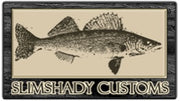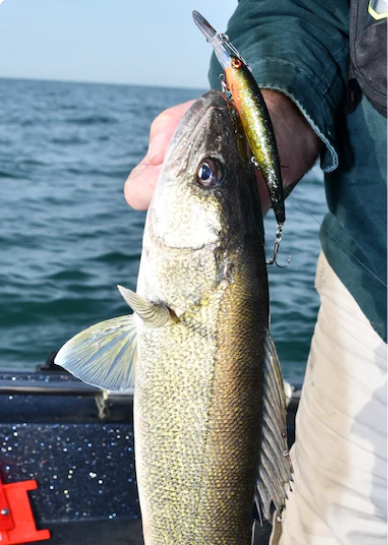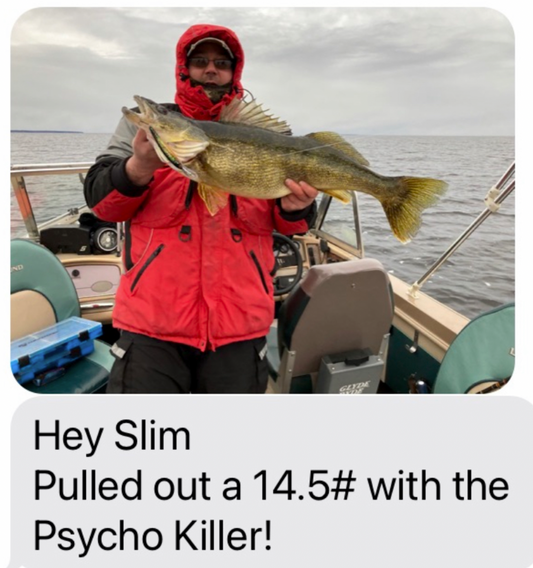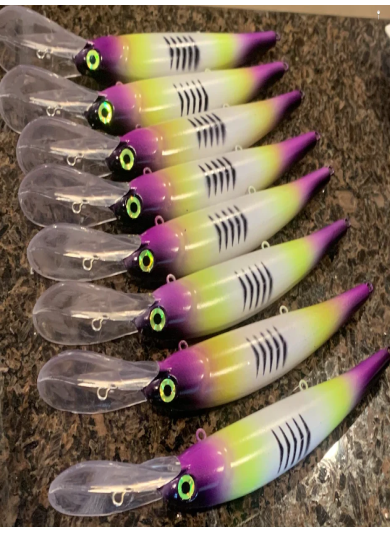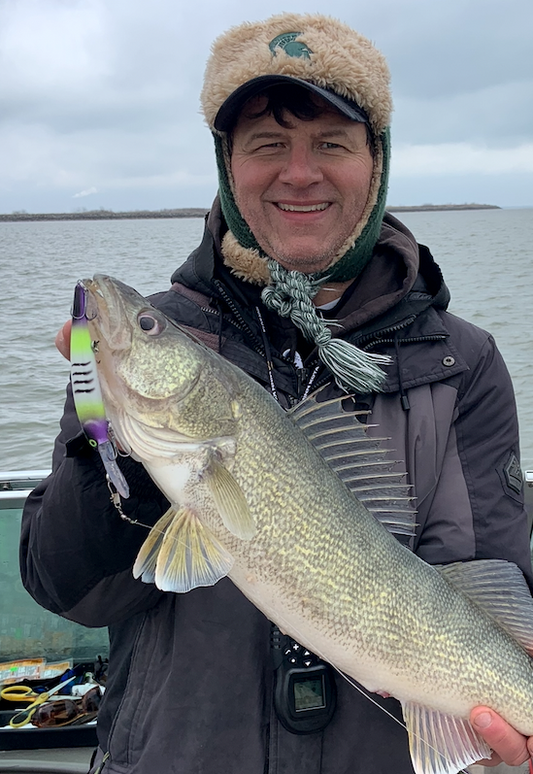Article: Crankbaits, harnesses or spoons, which option should I choose?
As a custom crankbait maker, you are probably thinking that this article will be written to convince you that crankbaits are always the way to go. Well, that's just not the case. There's a time and place for crankbaits, harnesses and spoons, along with a variety of other options for catching walleyes.
I primarily fish Lake Erie, Lake St. Clair, the Detroit River and occasionally the St. Clair River, therefore, this article is from that perspective. While these methods will work in other bodies of water, techniques for catching walleyes will vary wildly depending on where you are chasing them. Obviously, there's a big difference between fishing for walleyes in rivers or lakes, so I will cover them in separate articles. Today's article will be focused on "big-water" lake fishing.
I will break it down into 5 "seasons"; early-spring, late-spring, summer, early-fall and late-fall. This article will be focused on the first 2 "seasons". I will cover the others in subsequent articles.
Early Spring:
For the purposes of this article, I will classify early spring as the period from ice-out through the end of April. In MI and northern OH, this usually starts sometime in March. This is one of the best times to catch really big walleyes in this system, especially on Lake Erie. The area from Luna Pier to the Bass Islands is loaded with big fish during this time, and crankbaits are typically the tool of choice for Lake Erie trollers. That said, there are plenty of fish to be had around the reefs or near the Maumee River mouth for people who prefer to cast and/or drift with jigs & blade-baits. These methods tend to produce mostly "good eaters", but they can be a blast on light tackle. I am sure there are many other methods that might work during this time for those adventurous enough to give them a shot.
If you are "hog-hunting", then crankbaits are the way to go this time of the year (in my opinion). The water is typically still cold (36-42 degrees), so the fish aren't usually very aggressive. Therefore, I usually start out trolling them between 1.0 - 1.4 mph. However, it doesn't hurt to speed your baits up to 1.6 or 1.8 every now and then to trigger bites. If I get bites at the higher speeds, then I might keep my average speed up a bit higher. Depending on the wind conditions, I usually troll downwind with my electric and occasionally hit the "rabbit" button for a few seconds, which takes it up to full speed, then hit it again, going back to my previous speed.
Other times I will "kill it" and let the baits slow down for 5-10 seconds before re-engaging the motor. It is amazing how often these speed changes will trigger bites. Making turns can do this as well, because your outside boards will speed up and your inside boards will slow down. Be careful not to turn too sharply if you are running lots of boards on each side, or you can end up with a huge tangled mess. If I am consistently getting bites on the "slow side", I will usually take that as a sign that I need to slow down. If my average speed needs to be above 1.5 or so, I will usually start my kicker and then use the electric for minor speed adjustments and for steering.
The water color in the early spring is typically on the stained to muddy side, so choose your baits accordingly. I like wild contrasting colors the more stained the water is.

Here's an example of an early spring Lake Erie crankbait walleye. This fish was caught trolling a Pimp Daddy Perch near Luna Pier on March 11, 2021. It was one of 8 walleyes over 7 lbs that we caught that day (19 in total). I put her back (along with the other really big ones) so she could get a chance to drop those eggs.
Late Spring:
I consider "late spring" to be the time from the end of April through the middle of June. This is definitely a time of transition for the walleyes and for walleye fishing. The water during the early part of this "season" can still be pretty cold (low 50s to low 60s), therefore, crankbaits are still the tool of choice for most fisherman at this time. I generally speed things up a bit during this period, trolling anywhere from 1.5 - 2 mph on most days. The water color is typically still on the stained to muddy side, so I tend to select lures with high contrast. For example: UFO, Grave Digger, Neon Fruit Dots, Big Bad Bill, Red Wing, Pink Panties, etc.
For the "back-half" of late spring, I usually start to think about switching over to harnesses, depending on how the weather and water conditions are shaping up. I have heard from very reliable sources that harnesses will work during the cold water periods as well, however, I can't validate that from my own experience. I just haven't tried them. I would prefer not to have to buy crawlers and deal with the mess in my boat if I can catch them on cranks. But that comes down to preference.
As we get into June, we start to see some floating weeds showing up, which is usually the "trigger" that forces me to put the cranks away and move to harnesses. Floating weeds are a total pain to deal with when pulling cranks with lots of boards out. The further you are from the Detroit River the less floating weeds you usually have to deal with. I rarely see them around the Bass Islands or most of OH for that matter, so people fishing in those areas can usually stick with crankbaits much longer than we can in MI waters.
Lots of guys start changing over to spoons at this point, and they are very effective. Most will start with the smaller profile spoons at this stage, as that seems to be the size of the emerald shiners that are prevalent in the system at this time of year. Some guys use Jet divers, others use small Dipseys or Big John mini-discs, but they all work. For walleyes, speeds between 2 and 2.5 mph are usually about right for this time of year, however, that's just a starting point. Don't be afraid to try faster or slower if you are not catching.
Some guys will run spoons on one side and cranks on the other to see which is working better. That said, I do not recommend doing this with cranks/harnesses or spoons/harnesses, because the speeds needed for them are so different at this point of the season. If you are going to attempt this, then I would recommend using willow-leaf harnesses, as those blades are designed to work at higher speeds.
When it comes to pulling harnesses, most guys use the same trolling gear they do pulling cranks or spoons. There's certainly nothing wrong with doing that. However, I prefer catching walleyes on light spinning gear if I can do it that way. For that reason, I tend to do things a bit different than most when it comes to fishing with harnesses.
Here's my typical late spring harness set-up with 3 guys in the boat (fishing in US waters with a 3-rod limit):
- 4oz in-line weights (with harnesses) from my front rod holders or the lowest holders on my rod-trees, running them 2-3 feet from the bottom. I typically use light spinning rods for these. I back-reel them out counting the "turns" until I hit bottom, then reel them up one turn. If I am getting too many sheep, I will bring them up another turn or two. If the water is deep, or if we are trolling faster than 1.4, then I will switch these rods to 6 oz weights.
- Boards: 2 per side when fishing in US waters, or 1 per side when fishing in Canada. These rods would be line counters and would be in the upper part of my rod trees. I use Off-Shore boards, with DIY "tattle-flags" (however, other brands will certainly work). These lines are usually targeting the highest fish in the water column, therefore, I usually start them 20-40 feet back (from the boards) with one once weights and adjust from there. I usually run them 75 - 100 feet out to the sides of the boat (unless the boat traffic is really bad).
- 1oz/2oz in-lines run off the back of the boat, also with light spinning gear. I will also back-reel these, counting the turns. I try to keep the spinning reels that I use for this method consistent, and I calibrate how much line is let out with each turn back. Most of the time it is between 2 and 3 feet per turn. With 2 oz in-lines trolling at 1.5 mph or so, I get about 1 foot of depth for each "turn" as I back-reel them out. Hence, if I am marking fish 20-21 feet down, then I will back-reel to 19 turns and put them in the holder. I may adjust them in or out until we start catching fish.
If the fish are up higher, then I change to 1 oz in-line sinkers for the lines off the back. With 1 oz weights, the ratio is 2/3. We get about 2 feet of depth for every 3 turns. So 21 turns back would be roughly 14 feet down. Keep in mind that your speed and the type of line makes a big difference in how deep they will run. Braid will run deeper than flouro, and flouro runs deeper than mono (assuming the same line strength). If I put the rod in the starboard front rod-holder on my boat, I will usually be able to see the bait on the graph, so I can see exactly how deep it is running. I do that to calibrate the depths and then use that info to guage how many turns back I need to be. That said, I feel that being able to repeat your set-ups is more important than knowing exactly how far down you are, because I am constantly adjusting until I start getting bites. Once you get it "dialed-in", then we just keep repeating that set-up. Again, I choose to do it this way because I love fishing with light spinning gear. If you don't care about that, then just use your trolling gear with line counters.
Some days, most of the walleyes will come from the board rods. Other days, all of the rods will produce. If we are struggling to get fish on the "boat rods", then I might put one set of them away and run additional board rods. However, I have also seen it the other way around. When that happens, I put the boards away and just focus on the boat rods. I like to spread my gear out, both vertically and horizontally until I know what is working best, then adjust from there.
Towards the very end of the late-spring period, we may start to see some mayflies showing up. Especially during those warmer years. When that happens, I usually run my baits higher in the water column. This is the time of the year when casting weapon rigs can also work very well and is one of the most fun ways to catch walleyes (IMO). If you are not familiar with a "Weapon Rig", it is a "castable" harness, typically with a single hook, a smaller spinner blade and is usually around 18" in length. I tie mine with a big loop knot at the end, with a small bead in the loop. That way, I can slide various sized egg sinkers onto the loop before putting the loop in a snap-swivel, and the bead keeps the sinker from sliding down to the spinner. There are articles and videos that show you this in more detail. Weapon rigs mimic a mayfly larvae very well, which makes them a great choice this time of the year. It does take some experience to catch them casting, so keep that in mind if you have newbies in your crew. If you've never had the experience of feeling a big walleye hit a casted bait, with lots of line out and fighting them on light tackle, then you are missing out. I usually start out trolling until we get them dialed in, and then as we get close to a limit, we switch over to casting for the "fun-factor".
There is also a "hybrid" method that I like to employ this time of the year (during the mayfly hatch), as it is both fun and super effective. For the hybrid method, I use my trolling motor and point the boat down-wind. It is most effective when there is a light breeze (vs dead-calm or strong winds). I set the motor to a level that will push the boat up to around 1.7 or 1.8 mph. With my 20 foot Lund and 80 lb thrust motor, this is usually around a 6 or 7 setting. For gear, we use the same weapon rigs that we would use casting with a 1/3rd to 1/2 of a crawler. No more.
With 2 people in the boat, we have one cast on an angle to the right and the other on an angle to the left. If you have a 3rd person, have them cast straight back. I like to start with 1/2oz egg sinkers on each side then 5/8oz for the person going straight back. We cast the rigs as far as reasonably possible and hold the rod in your hands. I let the boat get up to speed (1.7 or 1.8) for 10-15 seconds, then I kill the motor and let the baits start to slow down, which allows them to fall slowly towards the bottom. As the baits are falling, I am counting (1-Mississippi, etc) to see how many seconds it takes for them to hit bottom. If mine hits bottom before the other 2 baits do, I have them let out more line. Ideally, I want them all hitting bottom about the same time. As soon as I feel my bait touch bottom I stop counting and then I re-engage the motor and the lures speed back up and begin to rise towards the surface. We usually get bites just after I re-engage the motor. Sometimes all 3 rods will get bit at the same time. We sometimes need to "tease them" into committing. If we are getting taps, we will slowly pull the rod forward a couple feet, then slowly drop it back and they will usually smack it.
However, if the boat gets back up to speed and we didn't have any bites, I will let it run for 15-20 seconds and then kill the motor again and repeat the process. Each time through the cycle, I will usually re-engage the motor one count sooner so that the bait is stopping short of the bottom and then letting the boat continue at the high-end one tick longer to get the baits higher before I slow them back down. I keep changing it up a bit each time until I find out what works best. If we had taps, but no fish, we usually reel it in to check the bait, then recast it out.
The lighter weights and long casts are key to this system, as that allows the baits to rise and fall in the water column as the speeds change. This mimics the mayfly larvae that are hatched on the bottom and swim to the surface. I have found that #4 gold spinners and either gold, amber or orange beads work best for this technique. If you use too heavy of weights, the baits won't rise very far on the fast end and they will hit the bottom too fast when you kill it. However, if the wind is blowing and I can't get the speed low enough for them to hit bottom, I will go one size heavier on the sinkers until we get it right.
Medium-light to medium-heavy spinning rods (6'6" - 7+ are ideal), with 3000 size spinning reels are perfect. I use 10 lb braid as my main-line, with 10-15 lb test flouro leaders tied with a uni-to-uni knot. I like to keep my leaders fairly long (10-15 feet), however, that is personal preference. You can certainly catch them using all mono or all flouro, but I much prefer casting with braid, plus the feel and hook-sets are better.
This technique works anywhere in the Western Basin during the mayfly hatch, however, it is especially effective near the many reefs that can be found around the Bass Islands.
Again, having the rod in your hands is critical. This is not a "put it in the holder and wait" technique. The nice thing is that it is easier for newbies to master than straight casting, yet it provides a similar amount of "thrill". Give it a shot the next time you see mayfly husks on the surface.
The mayfly hatch can span into the early summer period as well, however, I am covering it here within the late spring section.

Here's an example of a fish that fell victim to the hybrid method that I mentioned above. There were mayfly husks everywhere on this trip.
Stay tuned for the other 3 "seasons" in future blog posts.
I hope to see you on the water!!
Cheers, Mike Schlimgen (aka Slimshady)
